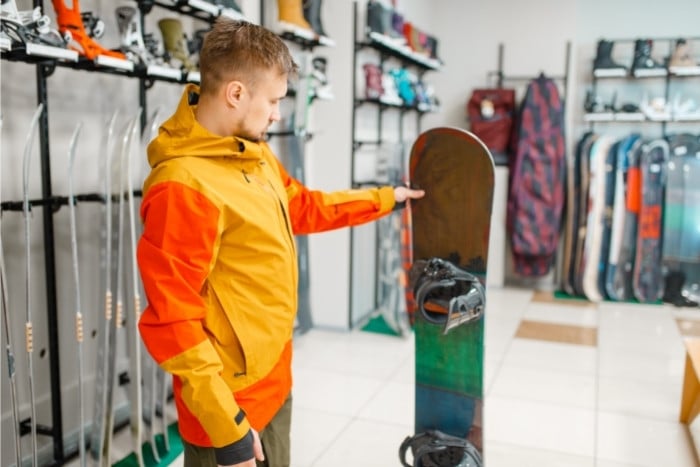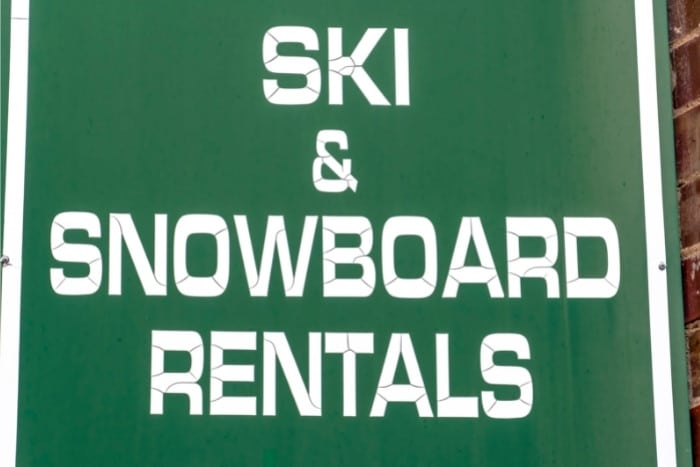Picking the perfect snowboard size can seem daunting at first, especially if you’re planning on investing in a board instead of renting. It can also be disheartening to spend a day on the mountain and struggle to control your board, not knowing whether it’s due to a lack of skill or poorly chosen equipment.
If your snowboard is too big, you can adjust your bindings setup to make it easier to stay balanced. While a bigger board can be trickier to control at first, with practice, you may find you prefer it to a shorter board. You’ll need to switch to a shorter model if you’re still struggling.
Below, we’ll take a look at what you need to know to make an informed decision when it comes to choosing the right snowboard size and how you can overcome performance issues if your board is slightly too big for you.
Solving The Oversized Snowboard Problem
1. Snowboard Sizing Guide
To figure out whether your snowboard is oversized, first, you need to know what’s considered the “right” size.
The idea of a perfectly sized snowboard is somewhat of a myth, as boards of different lengths and widths have their own perks and drawbacks depending on the snow conditions and the rider’s preferred style.
However, that doesn’t mean size guides aren’t valuable tools, as choosing the wrong board for your needs will diminish your fun on the slopes and could result in avoidable injury, especially for beginners.
It’s a common misconception that the length of a snowboard is determined by the rider’s height.
While there is some truth in this, the more important factor is body weight, as this affects how much the board will flex.
Snowboards are built with a specific amount of flex in mind, and if you’re too light for your board, it won’t flex as much as it should and will be harder to control.
Boards that are more flexible (whether through their construction or their size relative to the rider) are generally more forgiving of mistakes, as your physical input isn’t transferred as quickly as it would be with a stiffer board.
There is no standardized size guide for snowboarding, and every manufacturer publishes its own. In fact, sometimes, the guide will even differ from board to board.
Why? Because different snowboard models are constructed for different purposes.

2. When to Choose a Bigger or Smaller Board
Let’s say you’ve found your dream snowboard online and looked at the size chart to determine which length is recommended for you based on your body weight.
Should you take the recommendation as gospel? If you’re a beginner to intermediate snowboarder and spend most of your time on groomed slopes on an all-mountain board, following the chart is probably your best bet.
You may even want to go for a slightly shorter board if you don’t plan on hitting extremely high speeds, as they make turning much easier.
If you plan on fast downhill riding, a longer board will be more stable at higher speeds, so it may be a better option.
If freestyle snowboarding is your thing, a shorter, lighter board will make it much easier to jib, spin, and hit rails in the park.
On the flip side, if you’re all about that backcountry powder and ungroomed runs, a larger board will have a greater surface area that provides better flotation and will prevent you from sinking into the deep snow as you ride.
3. What If My Snowboard Is Too Wide?
That’s length covered, but what about width? As a rule of thumb, snowboards get longer as they get wider; however, some models offer wide versions of shorter boards.
This is because the width of your board is usually determined by your boot size rather than your weight.
It’s usually assumed that a rider with bigger feet will be taller and, therefore, heavier, but this isn’t always the case.
A snowboard is considered wide when the waist width is over 260mm, and most manufacturers recommend opting for a wide board if your boots are a US size 12 or above or a mid-wide board for sizes 10-12.
The heels and toes of your snowboard boots should slightly overhang the edges of your board, but not so much that they drag in the snow when engaging the board’s edges with the snow.
If your board is too wide for your feet, you’ll struggle to engage the edges effectively, making things like turning and stopping much trickier.
Conversely, if your board is too narrow, you’ll experience heel or toe drag, which at best will slow you down, and, at worst, cause you to crash and potentially injure yourself.
4. How to Ride a Bigger Board
If you’re stuck with a snowboard that’s slightly bigger than recommended, it doesn’t have to ruin your trip, as there are a few ways to adapt to the size.
It may sound obvious, but sticking it out with a longer board will make riding it easier over time. As your carving technique improves, you’ll find a bigger board to be more stable and responsive.
While it may be a steeper learning curve than using a shorter board, you’ll have a lot more fun on the mountain when you get to grips with it.
To make the process easier, consider adjusting your bindings setup. By increasing the space between your bindings, you’ll widen your riding stance and find your balance on the bigger board will improve.
Lastly, opt for a snowboard with greater flex if you have the choice.
As explained above, the increased flexibility of the board will compensate for the lower body weight-to-board ratio and allow for a more merciful riding experience.
5. How to Avoid Buying the Wrong Snowboard
If you’re planning on buying your own snowboard and are worried about spending your money on the wrong one, the best solution is to rent a variety of boards first and get an idea of which size and style is the best fit.
Speak to the team at the rental shop for advice on which boards to try out, as they’ll have plenty of invaluable experience.
Most shops are more than happy to let you switch boards throughout your trip, and if you’re really lucky, you may even be able to rent the exact model you’re hoping to buy.
Patience is important here – we know what it’s like when you see your dream snowboard and can’t stop picturing yourself flying down the mountain on it, but it’s worth taking your time to try a few different options.
Lastly, always be realistic about the style of riding you’re most likely to be doing and the weather conditions you’ll be riding in.
You may love the idea of floating around in deep powder on a long, wide backcountry board, but if you’re going to be spending most of your time on groomed slopes with no guarantee of big snow dumps, you’ll have a worse experience than if you stuck to a shorter, all-mountain setup.

Conclusion
Ultimately, the best way to avoid getting stuck with a board that’s too big for you is to do your research in advance.
Take a look at a sizing chart to get a rough idea of what size is best based on your weight and boot size, then factor in your intended riding style to increase or decrease the length.
Once you’ve figured that out, you can rent a few options to determine which board is the ideal one for you.
